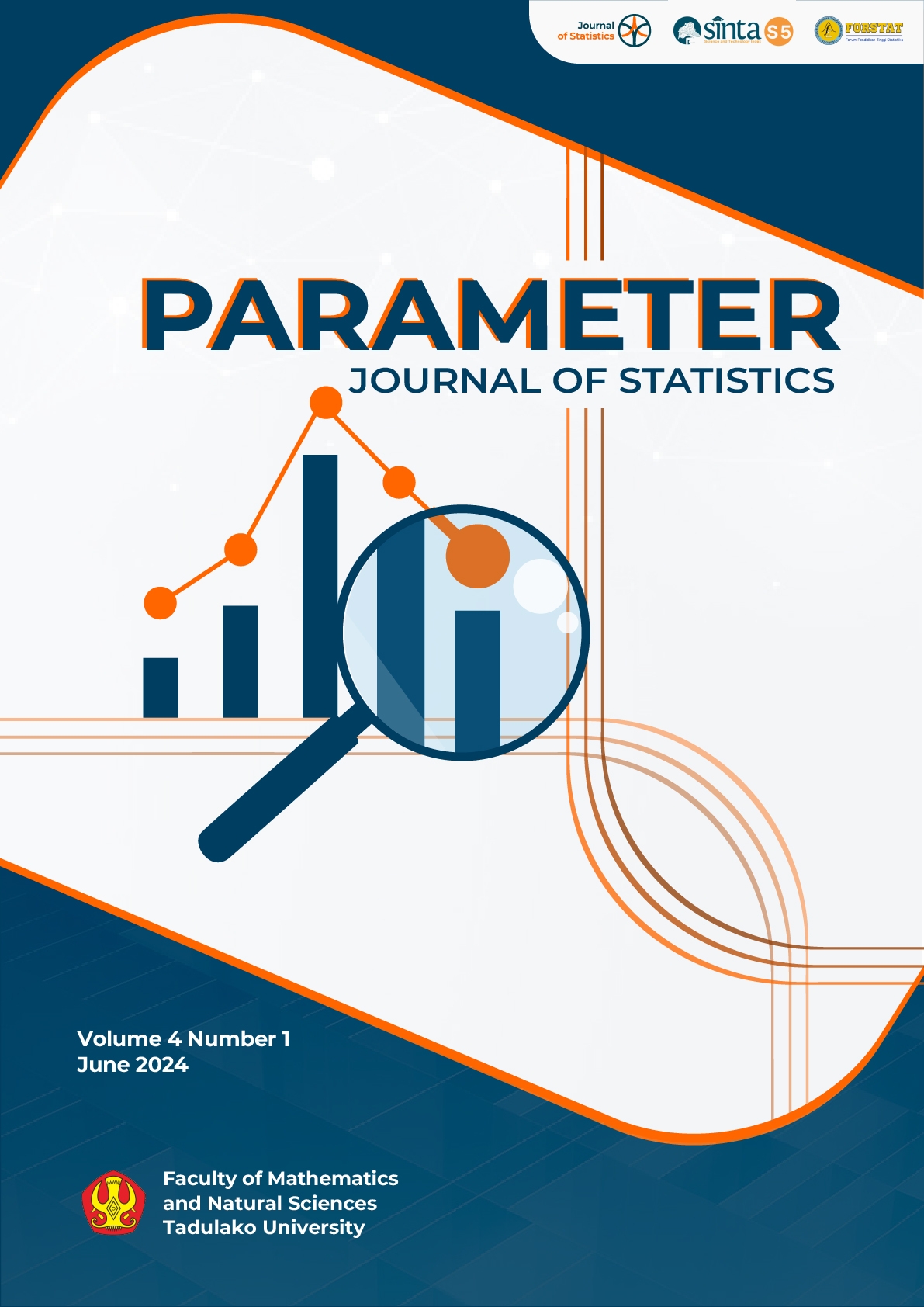Main Article Content
Abstract
Indonesia faces significant economic challenges, particularly inflation, which affects the economic, social, and cultural sectors. High inflation can exacerbate poverty, alter consumption patterns, and contribute to social injustice, whereas low inflation can enhance national income and stimulate economic activities. Given its fluctuating nature, inflation in Indonesia requires accurate forecasting to inform policy-making and economic decisions. This study aims to forecast inflation in Indonesia for the next eight months using the Autoregressive Integrated Moving Average (ARIMA) method. Monthly inflation data from January 2020 to April 2024 obtained from Bank Indonesia were analyzed. The ARIMA model, suitable for short-term forecasting, was selected due to its ability to handle data trends, non-stationarity, and noise filtering. The Augmented Dickey-Fuller (ADF) and Kwiatkowski-Phillips-Schmidt-Shin (KPSS) tests to ensure stationarity. Initial ADF tests showed the presence of a unit root in the original data and the first differencing data, but data became stationary after the second differencing. The KPSS test confirmed a unit root in the original data and trend stationarity after the second and third differencing. Ordinary Least Squares (OLS) regression on the original data revealed a significant time trend, indicating deterministic trends. The optimal model identified was ARIMA(0,2,1) with AIC=51.81, as it met the criteria for normality, independence, and zero mean of residuals. This model effectively forecasts inflation from May to December 2024, which showed an increase with inflation values ​​of 3.02, 3.05, 3.07, 3.10, 3.12, 3.14, 3.17, and 3.19.
Keywords
Article Details

This work is licensed under a Creative Commons Attribution-ShareAlike 4.0 International License.
References
- Asrirawan, Permata, S. U., & Fausan, M. I. (2022, January). Pendekatan Univariate Time Series Modelling untuk Prediksi Kuartalan Pertumbuhan Ekonomi Indonesia Pasca Vaksinasi COVID-19. Jambura Journal of Mathematics, 4(1), 86-103. doi:https://doi.org/10.34312/jjom.v4i1.11717.
- Bank Indonesia. (2023, July 6). Inflasi. Retrieved from bi.go.id: https://www.bi.go.id/id/fungsi-utama/moneter/inflasi/default.aspx.
- Dickey, D., & Fuller, W. (1979, June). Distribution of The Estimators for Autoregressive Time Series with a Unit Root. Journal of the American Statistical Association, 74(366), 427-431. Retrieved from https://www.jstor.org/stable/2286348.
- Efendi, Z., Laut, L. T., & Prasetyanto, P. K. (2020). Pengaruh Jumlah Penduduk, Inflasi, dan Pertumbuhan Ekonomi Terhadap Konsumsi Masyarakat di Kota Magelang. DINAMIC: Directory Journal of Economic, 2(3), 810-820. doi:10.31002/dinamic.v2i3.1425.
- Fajri, L. D. (2022, August 25). Mengenal Dampak Positif dan Negatif Inflasi Suatu Negara. Retrieved July 6, 2023, from katadata.co.id: https://katadata.co.id/intan/berita/6306e7f94a120/mengenal-dampak-positif-dan-negatif-inflasi-suatu-negara.
- Indonesian Cabinet Secretariat. (2023). No Title. https://setkab.go.id/en/president-jokowi-quick-economic-recovery-brings-indonesia-to-higher-level/.
- Jarque, C. M., & Bera, A. K. (1980). Efficient tests for normality, homoscedasticity and serial independence of regression residuals. Economics Letters, 6(3), 255–259. https://doi.org/10.1016/0165-1765(80)90024-5.
- Kwiatkowski, D., Phillips, P., Schmidt, P., & Shin, Y. (1992, October-December). Testing The Nul Hpothesis of Sationarity Against The Alternative of A Unit Root. Journal of Econometrics, 54(1-2), 159-178. Retrieved from https://www.sciencedirect.com/science/article/abs/pii/030440769290104Y.
- Ljung, G. M., & Box, G. E. P. (1978). On a measure of lack of fit in time series models. Biometrika, 65(2), 297–303. https://doi.org/10.1093/biomet/65.2.297
- Mahayana, I. B., Mullyadi, I., & Soraya, S. (2022, April 6). Peramalan Penjualan Helm dengan Metode ARIMA (Studi Kasus Bagus Store). INFERNSI, 5(1), 45-50. doi:: 10.12962/j27213862.v5i1.12469
- Mardiatillah, R., Panorama, M., & Sumantri, R. (2021). Pengaruh Pengangguran dan Inflasi Terhadap Tingkat Kemiskinan di Sumatera Selatan Tahun 2015-2019. KINERJA Jurnal Ekonomi dan Manajemen, 18(2), 279-287. Retrieved July 6, 2023, from https://journal.feb.unmul.ac.id/index.php/KINERJA/article/view/9139.
- Mulyani, R. (2020, Desember 2). Inflasi dan Cara Mengatasinya dalam Islam. Lisyabab Jurnal Studi Islam dan Sosial, 2(1), 268-278. Retrieved July 6, 2023, from https://lisyabab-staimas.e-journal.id/lisyabab/article/view/47/24.
- Qadrini, L., Asrirawan, Mahmudah, N., Fahmuddin, M., & Amri, I. F. (2021, January). Peramalan Inflow dan Outflow Uang Kartal Bank Indonesia dengan Pendekatan ARIMA, Time Series Regression (TSR), ARIMAX, dan NN di Lampung. Jurnal Matematika Statistika & Komputasi, 17(2), 166-177. doi:https://doi.org/10.20956/jmsk.v17i2.11803.
- Stockhausen, W., & Fogerty, M. (2007). Removing Observational Noise from Fisheries-Independent Time Series Data Using ARIMA Models. NOAA Fisheries Scientifc Publication Office, 105(1), 88-101. Retrieved July 6, 2023, from https://spo.nmfs.noaa.gov/sites/default/files/pdf-content/2007/1051/stockhausen.pdf.
